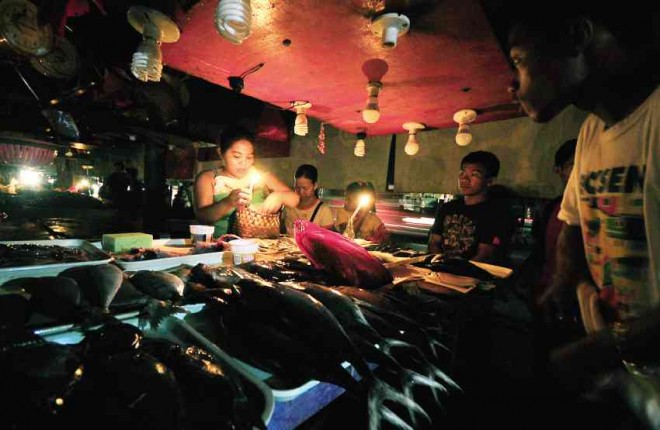Dams dry up, bring more brownouts

VENDORS use candles at Matina Public Market in Davao City after power supply in the city fell to precarious lows as a result of dams drying up and the continued absence of a stable, nonpolluting source of electricity. BING GONZALES/INQUIRER MINDANAO
DAVAO CITY, Philippines—In what could be the clearest illustration of the absence of a steady nonpolluting source of electricity, or efforts to have one, this city and other parts of Davao del Norte would suffer power outages lasting four to six hours a day as a result of dams drying up in the summer heat.
The Davao Light and Power Co. (DLPC), the main distributor of power in the province, said the National Power Corp. (Napocor) has failed to supply enough power to meet demand.
Napocor, a state agency, operates two major hydroelectric facilities in Mindanao, the Agus and Pulangi plants.
Art Milan, DLPC executive vice president and chief operating officer, said as of April 30, Napocor was able to deliver only 120 megawatts out of the 280 megawatts that DLPC needs to meet demand not only in this city but also in its other service areas like Panabo City and several towns in the province.
“The supply varies each day,” said Rodger Velasco, DLPC vice president for engineering. But one thing is certain, though, he said. The amount of power that Napocor delivers is not enough.
Article continues after this advertisementThe situation is expected to worsen as the turbines that generate power in the Agus and Pulani plants, which rely on water being hydroelectric facilities, are expected to slow down as a result of a sharp decline in the water level of Lake Lanao, from which the two plants draw its water supply.
Article continues after this advertisementVelasco said the lack of rain and the heat of the dry season have reduced the lake’s water level sharply.
At one point, he said, the Pulangi plant, which has a generating capacity of 265 MW, was able to generate only 10 MW.
Water level in Lake Lanao has fallen to 699.5 meters, dangerously close to the critical level of 699.15 when the Agus and Pulangi facilities have to stop operating completely or risk destroying their turbines.
“Only around one foot (left) and Lake Lanao already reaches critical level,” Velasco said.
DLPC also draws power from coal, a highly polluting source of energy, but even that is no longer enough. It is getting only 15 MW out of 30 MW that is supposed to be supplied by the generating firm Therma Marines Inc. (TMI), an Aboitiz-owned company, because of maintenance work on one of TMI’s generating units.
Still another coal plant, run by another Aboitiz firm, Hedcor, is able to generate only 38 MW out of 53 MW that it needs to generate.
The absence of a steady source of power is made more dramatic by the increase in demand. In the city alone, according to Milan, demand increased from a range of 260-280 MW in 2010 to a range of 300-310 MW today.
“Over the years, the entry of more investments without additional new generating capacity, has put a strain on our existing power supply,” he said.
The dry season heat is adding to the spike in demand. On April 29, he said, demand peaked to 330 MW “because it was too hot” prompting more consumers to use air-conditioning units.
In the entire Mindanao, Mindanao Development Authority (Minda) said there is a shortage of at least 314 MW mainly because of the reduced output of the Agus and Pulangi plants.
The shortage, said Minda, is “compounded” by the absence of supply from another coal plant, owned by the firm Steag and which is supposed to generate at least 200 MW. The plant is under repair.
Some electric cooperatives that distribute power have resorted to using modular generators while others are using bigger ones fueled by diesel. Germelina Lacorte, Inquirer Mindanao